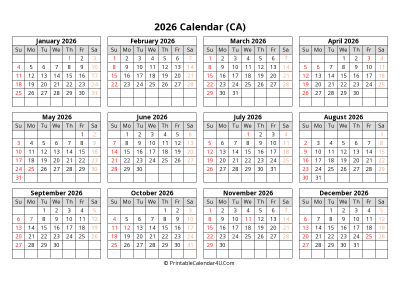Navigating Time: A Comprehensive Guide to the 2026 Canadian Calendar
Related Articles: Navigating Time: A Comprehensive Guide to the 2026 Canadian Calendar
Introduction
With enthusiasm, let’s navigate through the intriguing topic related to Navigating Time: A Comprehensive Guide to the 2026 Canadian Calendar. Let’s weave interesting information and offer fresh perspectives to the readers.
Table of Content
Navigating Time: A Comprehensive Guide to the 2026 Canadian Calendar

The year 2026, like any other, will unfold with its own unique rhythm, a tapestry woven with personal and national events. To effectively navigate this temporal journey, a reliable and comprehensive calendar becomes an indispensable tool. This guide delves into the intricacies of the 2026 Canadian calendar, exploring its structure, significance, and practical applications.
Understanding the Structure:
The 2026 Canadian calendar, like its predecessors, adheres to the Gregorian calendar system. This system, adopted by the majority of the world, divides the year into 12 months, with each month containing a specific number of days. The calendar prominently displays the days of the week, typically starting with Sunday and ending with Saturday.
Key Features and Significance:
The 2026 Canadian calendar is more than just a grid of dates; it serves as a vital resource for individuals, businesses, and institutions alike. It facilitates:
- Organization and Planning: The calendar provides a clear visual representation of the year, enabling users to schedule appointments, plan events, and manage deadlines effectively.
- Coordination and Communication: By providing a shared temporal framework, the calendar fosters seamless communication and coordination between individuals, teams, and organizations.
- Historical Awareness: The calendar highlights significant national holidays and observances, fostering a sense of national identity and commemorating important events in Canadian history.
Navigating the Calendar:
Several key features enhance the functionality and usability of the 2026 Canadian calendar:
- Public Holidays: The calendar prominently displays statutory holidays, such as New Year’s Day, Canada Day, and Christmas Day, ensuring individuals are aware of these non-working days.
- Provincial and Territorial Holidays: Some provinces and territories have unique holidays not observed nationally. The calendar will include these regional observances, ensuring accurate information for residents.
- Moon Phases: For those who follow lunar cycles, the calendar may include moon phases, providing insights into the changing celestial landscape.
- Additional Information: Printable calendars often include additional information, such as sunrise and sunset times, weather forecasts, or important contact numbers.
Practical Applications:
The 2026 Canadian calendar finds diverse applications across various sectors:
- Personal Use: Individuals use calendars for personal scheduling, managing appointments, tracking birthdays and anniversaries, and planning vacations.
- Business and Professional Use: Businesses rely on calendars for project management, team scheduling, meeting coordination, and deadline tracking.
- Educational Institutions: Schools and universities use calendars to organize academic schedules, holidays, and important events.
- Government and Public Services: Government agencies utilize calendars for managing public service delivery, legislative sessions, and important policy announcements.
Printable Calendars: A Digital and Physical Advantage:
The availability of printable 2026 Canadian calendars offers a distinct advantage:
- Accessibility: Printable calendars can be accessed and downloaded easily, ensuring widespread availability.
- Customization: Users can customize printable calendars by adding personal notes, highlighting important dates, and incorporating specific visual elements.
- Physical Presence: A physical calendar provides a tangible reminder of upcoming events and deadlines, fostering a sense of organization and visual clarity.
Frequently Asked Questions (FAQs):
Q1: Where can I find a printable 2026 Canadian calendar?
A1: Several online resources, including government websites, calendar-specific websites, and printing services, offer free or paid printable calendars.
Q2: Can I personalize a printable calendar?
A2: Yes, many printable calendars allow for customization. Users can add personal notes, highlight important dates, and even incorporate specific images or designs.
Q3: Are there specific features to look for in a 2026 Canadian calendar?
A3: Features such as public holidays, provincial and territorial holidays, moon phases, and additional information (sunrise/sunset times, weather forecasts) can enhance the calendar’s utility.
Q4: What are the benefits of using a printable calendar?
A4: Printable calendars offer accessibility, customization, and a tangible presence, promoting organization and visual clarity.
Tips for Using a 2026 Canadian Calendar:
- Plan Ahead: Utilize the calendar to schedule appointments, plan events, and manage deadlines proactively.
- Color-Coding: Employ different colors to categorize appointments, events, and tasks, enhancing visual organization.
- Regular Review: Regularly review the calendar to ensure accuracy and stay on top of upcoming commitments.
- Share with Others: Share relevant information from the calendar with colleagues, family members, or friends to facilitate seamless coordination.
Conclusion:
The 2026 Canadian calendar serves as a vital tool for navigating the year effectively. Its structure, key features, and practical applications empower individuals, businesses, and institutions to organize, coordinate, and manage their time efficiently. By embracing the calendar’s functionality and utilizing its diverse features, users can maximize its potential to achieve their goals and navigate the complexities of the year with clarity and purpose.








Closure
Thus, we hope this article has provided valuable insights into Navigating Time: A Comprehensive Guide to the 2026 Canadian Calendar. We thank you for taking the time to read this article. See you in our next article!